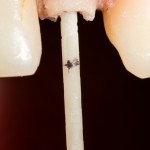
The restoration of endodontically treated teeth with significant coronal destruction is a clinical challenge. Traditionally this has been managed with an intra-radicular post and separate care and crown. Endocrown restorations where intra-radicular post, the core, and the crown are assembled in one component is an approach growing in popularity
The aim of the review was to assess clinical and in vitro studies that evaluated endocrown restorations compared to conventional treatments (intraradicular posts, direct composite resin, inlays/onlays).
Methods
Searches were conducted in the Medline, Lilacs, Ibecs, Web of Science, BBO, Scielo and Scopus databases. Clinical trials evaluating endocrown restorations or in vitro studies that evaluated fracture strength of endocrowns compared to conventional treatments (intraradicular posts, direct composite resin, inlay/onlay) were considered.
Two reviewers independently selected studies, abstracted data and assessed study quality. The Cochrane risk of bias tool and GRADE approach were used to assess quality. In vitro studies were assessed separately.
Results
- 8 studies (3 clinical, 5 in-vitro) were included.
- 2 of the 3 clinical studies were retrospective 1 prospective with follow up periods ranging from 6-36 months and success rates varying from 94 -100%
- The quality of the clinical studies was considered to be very low.
- Meta-analysis of in-vitro studies for both posterior and anterior teeth favoured endocrowns.
Conclusions
The authors concluded: –
The available literature found suggests that endocrowns may perform similarly or better than the conventional treatments using intraradicular posts, direct composite resin or inlay/onlay restorations. However, caution must be taken when interpreting the results of in vitro studies. Further studies are needed to confirm that endocrown restorations for endodontically treated teeth are a feasible option.
Comments
While an extensive search has been conducted for studies to address this question and a standardised methodological approach has been followed only a small number of small studies have been identified. The 5 in-vitro studies only tested 148 teeth and the clinical studies only assessed 55 teeth. The reviewers themselves classify the quality available evidence as very low and understandable given the fact that two of the clinical studies are retrospective and all 3 are very small. Further high quality studies of suitable duration are needed before this approach can be recommended.
Links
Primary paper
Sedrez-Porto JA, Rosa WL, da Silva AF, Münchow EA, Pereira-Cenci T. Endocrown restorations: A systematic review and meta-analysis. J Dent. 2016 Sep;52:8-14. doi: 10.1016/j.jdent.2016.07.005. Epub 2016 Jul 12. Review. PubMed PMID: 27421989.

[…] post Endocrown restorations – little evidence to support this approach appeared […]
Endocrown restorations – little evidence to support the approach https://t.co/xVkrh4GTzA
Only very low quality evidence available to support endocrown restorations https://t.co/xVkrh4GTzA
Very low quality evidence suggests endocrown restorations perform similar to conventional approaches https://t.co/xVkrh4GTzA
Evidence to support endocrown restorations is sparse and of low quality https://t.co/xVkrh4GTzA
Don’t miss- Endocrown restorations – little evidence to support this approach https://t.co/xVkrh4GTzA